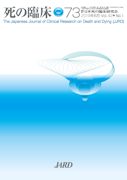Current issue
The Japanese Journal of Clinical Research on Death and Dying
Displaying 1-5 of 5 articles from this issue
- |<
- <
- 1
- >
- >|
-
2023 Volume 45 Issue 1 Pages 126-133
Published: 2023
Released on J-STAGE: August 15, 2023
Advance online publication: April 03, 2023Download PDF (428K)
-
2023 Volume 45 Issue 1 Pages 134-140
Published: 2023
Released on J-STAGE: August 15, 2023
Advance online publication: November 08, 2022Download PDF (427K) -
2023 Volume 45 Issue 1 Pages 141-144
Published: 2023
Released on J-STAGE: August 15, 2023
Advance online publication: April 03, 2023Download PDF (1235K) -
2023 Volume 45 Issue 1 Pages 145-151
Published: 2023
Released on J-STAGE: August 15, 2023
Download PDF (495K) -
Effectiveness of an online end-of-life care training program at a geriatric health services facility2023 Volume 45 Issue 1 Pages 152-159
Published: 2023
Released on J-STAGE: August 15, 2023
Download PDF (438K)
- |<
- <
- 1
- >
- >|
